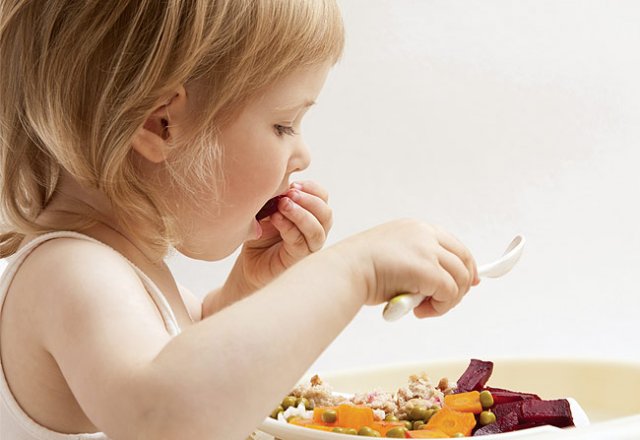
6 ways to combat fussy eating
6 ways to combat fussy eating

If you’re committed to eating healthy foods, you know how frustrating it is when your toddler isn’t on board. You probably resort to hiding vegetables, offering their favourite foods, or trotting out the ‘starving children in Africa’ guilt trip. But these tricks take away their chances to accept different foods. Worse – the harder you try and the more stressed you feel, the more damage you could be unintentionally doing. So what are salad-loving parents to do? Fortunately, there are ways to enjoy mealtimes and still raise a well-nourished little champion.
1. Put yourself in their (tiny) shoes
According to the Victorian Government, one in two toddlers are fussy eaters and eight out of 10 Australian parents worry about their child’s eating habits. But Natasha Meerding, accredited practising dietitian and spokesperson for the Dietitians Association of Australia, says evolution might have given toddlers good reason to be fussy. She says they’re not just disagreeable but naturally neophobic – designed to fear new tastes and textures. “You can imagine back when we were living in the cave that it wasn’t beneficial for a toddler to just wander off and eat whatever they fancied. There might have been poison berries or something else,” says Meerding.
Fussy eating can also be a sign of the normal slowdown in growth and energy needs as babies become toddlers. Meerding says: “They might not actually be hungry... A two-or three-year-old could be eating much less than a one-year-old.”
Another normal part of kids’ development is learning to get the responses they want. When they refuse the broccoli you dished up and you replace it with the cheese they love, they’ll soon make the connection. Giving them the food they want is a natural reaction from parents who want their kids to eat something, but it can be dangerous, says Meerding. “They soon work out what they want to happen and repeat the behaviour that gets them what they want.”
Don’t reward their refusal by bringing out their favourite foods. Even if their preferred food is nutritious, sticking to a narrow menu robs the child of the chance to enjoy different tastes and textures from all the food groups.
2. Resign as short-order cook
To keep the peace, many parents become ‘short-order cooks’, making different meals for everyone in the family. If this is you, it’s time to resign from the role. Just make one healthy meal for everyone and expect them to eat it. “If they see you eating it and enjoying it, they’re more likely to eat it themselves. They want to be just like Mum and Dad,” says Meerding.
Don’t shy away from serving vegetables in plain sight, either. Traditionally, mothers were encouraged to grate and puree vegetables or hide them in sauces and other foods, long after the child had moved beyond ‘baby food’. Meerding says, “Grating and pureeing vegetables can be an okay thing to do occasionally, but we really want kids to be able to see and try and get to know the different vegetables and flavours.”
3. Don’t make eating the only goal
Because reducing kids’ neophobia is the key to preventing and dealing with fussiness, exposure to new foods is more important than actually eating them. Just seeing it on the plate is a win for healthy eating. Research shows that most of us only offer a food three to five times before giving up, but Meerding says: “It’s really important that babies and kids have exposure to food multiple times. Seeing it, tasting it, and eating it. They sometimes have to taste it up to and more than 10 times...without even eating the whole portion. They need to be offered the food over and over again and not substitute the food for less healthy foods.”
This makes perseverance a parent’s most important quality. It takes fortitude to offer a few slices of zucchini or a spoonful of hummus every day for more than a week (for example), knowing it’s likely to end up in the dog’s bowl or the compost bin.
To strengthen your resolve, make clear what you and your child are each responsible for. Meerding says: “It’s the parents’ role to offer healthy foods and snacks at regular intervals. It’s the toddler’s role to decide how much they eat and if they’re going to eat.” Don’t put the ‘airplane’ (spoon) in a holding pattern right in front of their mouth; give them independence. “After they’re one, kids want to feed themselves rather than have someone else pick up food and put it in their mouth. Put food on their plate and let them choose whether they eat it,” says Meerding.
Even if the kids don’t want to eat, they can sit at the table and talk. “Meals are about more than just eating the healthy food, they should also be about enjoying each other’s company,” says Meerding. If mealtimes are a pleasant experience, kids will enjoy being there and will learn about conversation as well as food.
4. Give them a starring role
To pique kids’ interest in healthy foods, Meerding says: “Go and see where they come from in the garden or in the vegetable market. Get them involved in the growing, preparation, cooking and serving of the meal.” She recommends making hands-on foods that fulfil their growing need for independence and creativity.
Let them wear the chef’s hat by making mini pizzas on a wholemeal muffin, stuffing their own wraps or dipping foods into different sauces. It can be messier to let your child wield their food by themselves, but “allowing a child that mess and independence actually helps in the long run with them being a healthy eater,” says Meerding.
5. Stop caring
So you’ve carefully decided on what you’ll serve for dinner, involved your toddler in getting it on the table, and the family is now relaxing over the meal. You’re displaying your enjoyment of the food but your toddler is callously unimpressed. What are you to do?
When faced with food refusal, don’t reward them with an entertaining reaction. Meerding says: “If they are refusing certain foods, remove the food calmly and try not to get upset. Assume the child is full. Appetites vary from day to day and meal to meal.” Remind them that there won’t be any more food until the next meal or snack.
Their fussiness might be tiresome if you’re keen to feed them well, but pressuring your kids or feeling stressed about their eating is counterproductive. “It makes the meal time unpleasant for all, and stops the child being relaxed enough to try new foods. And most importantly, it makes meals a negative experience for the child, which can exacerbate fussy eating and other unwanted behaviour at meals,” says Meerding.
There are easier things than pretending you don’t care what your little one eats. But it can put things in perspective to think of the countless children who really are starving and how well your child eats in comparison. It may be small comfort when you’re scraping dinner from the floor or the walls, but your patience and persistence will ultimately nourish your kids for the rest of their long, healthy lives.
6. Make it easy for them
Although you expect your kids to eat the same as the rest of the family, you can tweak things to help them out.
• Keep regular eating routines to prevent the child being too hungry or full before meals.
• If your little one is too tired to enjoy their dinner, move the main meal to lunch.
• Separate foods rather than mixing them up so they can see what they’re eating.
• Offer a new food alongside one they already enjoy.
• Put just a few small pieces on their plate at a time.
Louise Wedgwood is a health and wellbeing writer, and a parent. She writes for magazines, businesses and at wellnessinwords.com.au. She’d love to continue the conversation with you on Twitter @louisewedgwood
Browse recipes for kids and try this lunchbox detox!















